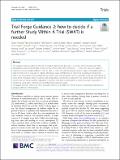Files in this item
Trial Forge Guidance 2 : how to decide if a further Study Within A Trial (SWAT) is needed
Item metadata
| dc.contributor.author | Treweek, Shaun | |
| dc.contributor.author | Bevan, Simon | |
| dc.contributor.author | Bower, Peter | |
| dc.contributor.author | Briel, Matthias | |
| dc.contributor.author | Campbell, Marion | |
| dc.contributor.author | Christie, Jacquie | |
| dc.contributor.author | Collett, Clive | |
| dc.contributor.author | Cotton, Seonaidh | |
| dc.contributor.author | Devane, Declan | |
| dc.contributor.author | El Feky, Adel | |
| dc.contributor.author | Galvin, Sandra | |
| dc.contributor.author | Gardner, Heidi | |
| dc.contributor.author | Gillies, Katie | |
| dc.contributor.author | Hood, Kerenza | |
| dc.contributor.author | Jansen, Jan | |
| dc.contributor.author | Littleford, Roberta | |
| dc.contributor.author | Parker, Adwoa | |
| dc.contributor.author | Ramsay, Craig | |
| dc.contributor.author | Restrup, Lynne | |
| dc.contributor.author | Sullivan, Frank | |
| dc.contributor.author | Torgerson, David | |
| dc.contributor.author | Tremain, Liz | |
| dc.contributor.author | von Elm, Erik | |
| dc.contributor.author | Westmore, Matthew | |
| dc.contributor.author | Williams, Hywel | |
| dc.contributor.author | Williamson, Paula R | |
| dc.contributor.author | Clarke, Mike | |
| dc.date.accessioned | 2020-01-17T13:30:04Z | |
| dc.date.available | 2020-01-17T13:30:04Z | |
| dc.date.issued | 2020-01-07 | |
| dc.identifier | 265773206 | |
| dc.identifier | 660f0830-f799-4c78-9420-fec0aba45f78 | |
| dc.identifier | 31910861 | |
| dc.identifier | 85077700141 | |
| dc.identifier | 000514643000003 | |
| dc.identifier.citation | Treweek , S , Bevan , S , Bower , P , Briel , M , Campbell , M , Christie , J , Collett , C , Cotton , S , Devane , D , El Feky , A , Galvin , S , Gardner , H , Gillies , K , Hood , K , Jansen , J , Littleford , R , Parker , A , Ramsay , C , Restrup , L , Sullivan , F , Torgerson , D , Tremain , L , von Elm , E , Westmore , M , Williams , H , Williamson , P R & Clarke , M 2020 , ' Trial Forge Guidance 2 : how to decide if a further Study Within A Trial (SWAT) is needed ' , Trials , vol. 21 , 33 . https://doi.org/10.1186/s13063-019-3980-5 | en |
| dc.identifier.issn | 1745-6215 | |
| dc.identifier.other | PubMedCentral: PMC6945587 | |
| dc.identifier.other | ORCID: /0000-0002-6623-4964/work/67526037 | |
| dc.identifier.uri | https://hdl.handle.net/10023/19302 | |
| dc.description | The work described here was discussed at and after a meeting held in Aberdeen on 23 March 2017, which was funded by the Medical Research Council (MRC) Network of Hubs for Trials Methodology Research (Grant Reference: MR/L004933/1– B2) and the Health Research Board – Trials Methodology Research Network (Ireland). | en |
| dc.description.abstract | The evidence base available to trialists to support trial process decisions—e.g. how best to recruit and retain participants, how to collect data or how to share the results with participants—is thin. One way to fill gaps in evidence is to run Studies Within A Trial, or SWATs. These are self-contained research studies embedded within a host trial that aim to evaluate or explore alternative ways of delivering or organising a particular trial process. SWATs are increasingly being supported by funders and considered by trialists, especially in the UK and Ireland. At some point, increasing SWAT evidence will lead funders and trialists to ask: given the current body of evidence for a SWAT, do we need a further evaluation in another host trial? A framework for answering such a question is needed to avoid SWATs themselves contributing to research waste. This paper presents criteria on when enough evidence is available for SWATs that use randomised allocation to compare different interventions. | |
| dc.format.extent | 9 | |
| dc.format.extent | 1123042 | |
| dc.language.iso | eng | |
| dc.relation.ispartof | Trials | en |
| dc.subject | RA Public aspects of medicine | en |
| dc.subject | T-NDAS | en |
| dc.subject.lcc | RA | en |
| dc.title | Trial Forge Guidance 2 : how to decide if a further Study Within A Trial (SWAT) is needed | en |
| dc.type | Journal article | en |
| dc.contributor.institution | University of St Andrews. School of Medicine | en |
| dc.contributor.institution | University of St Andrews. Sir James Mackenzie Institute for Early Diagnosis | en |
| dc.contributor.institution | University of St Andrews. Population and Behavioural Science Division | en |
| dc.identifier.doi | https://doi.org/10.1186/s13063-019-3980-5 | |
| dc.description.status | Peer reviewed | en |
This item appears in the following Collection(s)
Items in the St Andrews Research Repository are protected by copyright, with all rights reserved, unless otherwise indicated.

